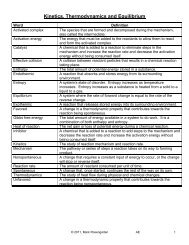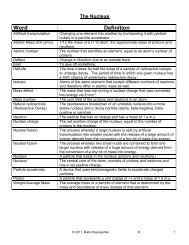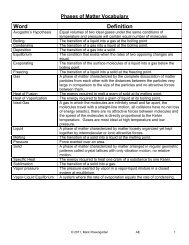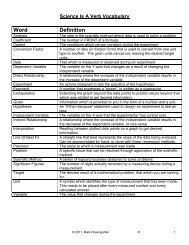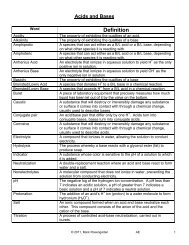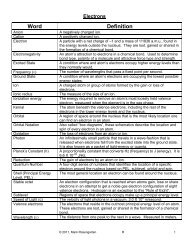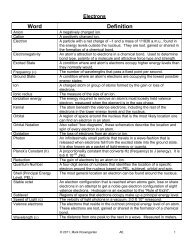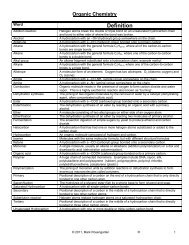Solutions - Mark Rosengarten
Solutions - Mark Rosengarten
Solutions - Mark Rosengarten
You also want an ePaper? Increase the reach of your titles
YUMPU automatically turns print PDFs into web optimized ePapers that Google loves.
B) To make a specific volume of solution with a desired molarity,<br />
The equation M = moles/L can be rearranged to solve for moles: moles = M X L<br />
1) Determine the desired concentration (what is the molarity of the solution you are trying to make?)<br />
2) Determine how much solution you want to make (how many L of solution do you need to make?)<br />
3) Multiply the two. This will give you moles. (M X L = moles. If you are given mL, convert to L first)<br />
4) Determine the formula mass of the solute. (FM = sum of atomic masses of all atoms in the compound, to the<br />
tenths<br />
place)<br />
5) Multiply the number of moles of solute calculated in step 3 by the formula mass of the solute. This will tell<br />
you how many grams of solute are needed. (moles X formula mass = grams)<br />
6) Mix with enough solvent to make the desired volume of solution. This is usually carried out in a volumetric<br />
flask.<br />
Who needs to do this? I, your chemistry teacher, needs to do this, every time I make a solution for you to use in lab.<br />
Anyone who works with chemicals needs to do thismedical, biological, geologicalany profession that uses<br />
solutions will involve using this calculation. It is actually one of the most practical calculations you are learning in this<br />
course!<br />
How many grams of NaOH are needed to make 4.0 L of a 0.50 M solution of NaOH?<br />
First, determine how many moles are needed: Moles = M X L = (0.50 moles/L) X (4.0 L) = 2.0 moles of NaOH<br />
Then, convert moles to grams: (2.0 moles) X (40.0 g/mole) = 80. grams of NaOH are needed.<br />
So, now you can weigh out 80. grams of NaOH on a triple-beam or digital balance and put it into a 4.0 L volumetric<br />
flask and fill it to the top line with distilled water.<br />
How many grams of KCl are needed to make 500. mL of a 0.100 M solution of KCl?<br />
First, convert the 500. mL to L: (500. mL) / (1000 mL/L) = 0.500 L<br />
Second, determine how many moles are needed: Moles = M X L = (0.100 moles/L) X (0.500 L) = 0.0500 mol of NaOH<br />
Then, convert moles to grams: (0.0500 moles) X (74.6 g/mole) = 3.73 grams of KCl are needed.<br />
So, now you can weigh out 3.73 grams of KCl on a triple-beam or digital balance and put it into a 500. mL volumetric<br />
flask and fill it to the top line with distilled water.<br />
3) Parts Per Million (ppm) = (grams of solute/grams of solution) X 1 000 000<br />
Used to determine trace amounts of dissolved ions in drinking water. Established toxic threshold levels are reported in<br />
ppm or sometimes ppb (parts per billion) if it is a particularly nasty toxin. It is also used to measure the concentration<br />
of particulates in the air. Air pollution is measured in parts per million, as is dust in a clean room at an electronics<br />
manufacturing plant.<br />
What is the concentration, in ppm, of lead ions in 100. g of tap water with 0.0000450 g of lead ions dissolved in<br />
it?<br />
ppm = (g of solute / grams of solution) X 1 000 000 = {(0.0000450 g) / (100. g)] X 1 000 000 = 0.45 ppm<br />
© 2011 <strong>Mark</strong> H. <strong>Rosengarten</strong> R 8



